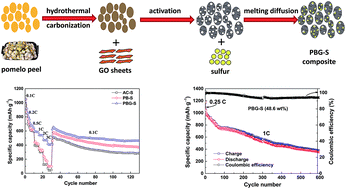当前位置:
X-MOL 学术
›
Sustain. Energy Fuels
›
论文详情
Our official English website, www.x-mol.net, welcomes your
feedback! (Note: you will need to create a separate account there.)
Porous 3D graphene-based biochar materials with high areal sulfur loading for lithium–sulfur batteries†
Sustainable Energy & Fuels ( IF 5.0 ) Pub Date : 2018-08-10 00:00:00 , DOI: 10.1039/c8se00343b Daoqing Liu 1, 2, 3, 4, 5 , Qianwei Li 4, 6, 7, 8, 9 , Jinbao Hou 4, 10, 11, 12 , Huazhang Zhao 1, 2, 3, 4, 5
Sustainable Energy & Fuels ( IF 5.0 ) Pub Date : 2018-08-10 00:00:00 , DOI: 10.1039/c8se00343b Daoqing Liu 1, 2, 3, 4, 5 , Qianwei Li 4, 6, 7, 8, 9 , Jinbao Hou 4, 10, 11, 12 , Huazhang Zhao 1, 2, 3, 4, 5
Affiliation

|
The low electronic conductivity of sulfur and the high solubility of polysulfides seriously hinder the practical application of lithium–sulfur (Li–S) batteries. Therefore, the incorporation of sulfur into carbon-based materials is considered as a suitable solution. Here, a porous pomelo biochar/graphene composite (PBG) was prepared via a simple and green method combining hydrothermal carbonization and KOH activation. The obtained material was used as a host to encapsulate sulfur for the cathode of Li–S batteries, and the three-dimensional pore structure with enhanced conductivity is beneficial for the utilization of sulfur and absorption of soluble polysulfides. As a result, the PBG-S composite (63.3 wt% sulfur) delivered an initial discharge capacity of 1053 mA h g−1 at 0.1C (1C = 1675 mA g−1) and retained 418 mA h g−1 at 3C, even with a high sulfur loading of 4.0 mg cm−2. In addition, the performance of the composite was further improved by reducing the content of sulfur to an appropriate ratio in the PBG-S composite. The optimized PBG-S composite (48.6 wt% sulfur) exhibited a high initial discharge capacity of 1368 mA h g−1 at 0.1C and retained 638 mA h g−1 at 3C, and the discharge capacity remained as high as 664 mA h g−1 and 354 mA h g−1 even after the 200th and 600th cycles at 1C, respectively. The results indicated that PBG, with excellent electrochemical properties, is an ideal electrode material for lithium–sulfur batteries, and can also be prepared economically on an industrial scale.
中文翻译:

锂硫电池多孔3D石墨烯基生物炭材料,具有较高的面硫负载†
硫的低电子电导率和多硫化物的高溶解度严重阻碍了锂硫(Li–S)电池的实际应用。因此,将硫掺入碳基材料中被认为是合适的解决方案。在这里,通过将水热碳化和KOH活化相结合的简单且绿色的方法,制备了多孔柚生物炭/石墨烯复合材料(PBG)。所得材料用作锂硫电池正极的硫包封主体,具有增强电导率的三维孔结构有利于硫的利用和可溶性多硫化物的吸收。结果,PBG-S复合材料(硫含量为63.3重量%)的初始放电容量为1053 mA hg -1在0.1C(1C = 1675 mA g -1)的条件下,即使在4.0 mg cm -2的高硫负载下,在3C时仍保持418 mA hg -1。另外,通过将PBG-S复合物中的硫含量降低至适当的比例,可以进一步提高复合物的性能。优化的PBG-S复合材料(48.6 wt%的硫)在0.1C时显示出1368 mA hg -1的高初始放电容量,在3C时保留了638 mA hg -1的放电容量,并且放电容量仍然高达664 mA hg -1和354毫安汞柱-1即使在200次和600次分别在1C下循环。结果表明,PBG具有优异的电化学性能,是锂硫电池的理想电极材料,也可以工业规模经济地制备。
更新日期:2018-08-10
中文翻译:

锂硫电池多孔3D石墨烯基生物炭材料,具有较高的面硫负载†
硫的低电子电导率和多硫化物的高溶解度严重阻碍了锂硫(Li–S)电池的实际应用。因此,将硫掺入碳基材料中被认为是合适的解决方案。在这里,通过将水热碳化和KOH活化相结合的简单且绿色的方法,制备了多孔柚生物炭/石墨烯复合材料(PBG)。所得材料用作锂硫电池正极的硫包封主体,具有增强电导率的三维孔结构有利于硫的利用和可溶性多硫化物的吸收。结果,PBG-S复合材料(硫含量为63.3重量%)的初始放电容量为1053 mA hg -1在0.1C(1C = 1675 mA g -1)的条件下,即使在4.0 mg cm -2的高硫负载下,在3C时仍保持418 mA hg -1。另外,通过将PBG-S复合物中的硫含量降低至适当的比例,可以进一步提高复合物的性能。优化的PBG-S复合材料(48.6 wt%的硫)在0.1C时显示出1368 mA hg -1的高初始放电容量,在3C时保留了638 mA hg -1的放电容量,并且放电容量仍然高达664 mA hg -1和354毫安汞柱-1即使在200次和600次分别在1C下循环。结果表明,PBG具有优异的电化学性能,是锂硫电池的理想电极材料,也可以工业规模经济地制备。











































 京公网安备 11010802027423号
京公网安备 11010802027423号